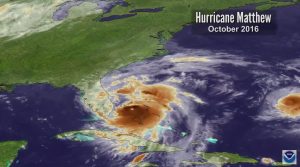By James Thompson
Contributor, EDM Digest
Hurricane experts predict that 2017 will be a busy hurricane season, similar to 2016. The hurricane season of 2016 was the most active season since 2012 and resulted in 15 named storms.
Hurricane season officially kicked off on June 1, 2017. While most Americans are thinking about beach vacations in Gulf and the Southeast Atlantic areas over the summer, officials at the National Oceanic and Atmospheric Administration (NOAA) informed first responders and the general public about the potential for a highly active hurricane season.
Leading NOAA Forecaster Says to Expect ‘Above-Normal Atlantic Hurricane Season’
The NOAA Prediction Center in College Park, Maryland issued the 2017 Atlantic Hurricane Season Outlook, hosted by NOAA Lead Seasonal Hurricane Forecaster Dr. Gerry Bell. From now until November 30, when the hurricane season ends, officials are expecting a busier than normal activity in the Atlantic.
“For 2017, my team and I are predicting that an above-normal Atlantic hurricane season is most likely,” Dr. Bell stated. “The Atlantic hurricane season will likely produce a range of 11 to 17 tropical storms of which five to nine are expected to become hurricanes — two to four of those are expected to become major hurricanes of category 3 or higher.”
In the video, Dr. Bell reminds viewers, “Last year, we saw five land-falling storms, two of which were hurricanes. One of those storms was Hurricane Matthew, which caused 10 billion dollars in U.S. economic losses due to wind and water damage.”
Early Preparation is Vital to Survival and Limiting Losses
Whether you’re an emergency manager, first responder or a citizen living in a region commonly affected by hurricanes, now is a good time to review procedures to keep yourself safe and ensure maximum preparedness.
“The best advice that I can give is to have a plan — know the risks, evacuation routes and shelter locations,” says leading emergency management and homeland security expert Dr. Chris Reynolds of American Public University System. As Dean of Academic Outreach and Program Development, Dr. Reynolds has over 35 years of direct and higher incident command operations responding to the most severe natural and man-made disasters worldwide that dominated news headlines.
Dr. Reynolds warns that you shouldn’t wait to create an emergency plan. He notes that “It’s important to have a home disaster kit that can easily be transported that contains subsistence and any medication that you are prescribed for 72 hours.

If you receive an evacuation order, heed it and evacuate! Deciding to “ride it out” not only puts you and your family at risk, but also risks the lives of the emergency responders who may have to rescue you!
In a perfect world, everyone would be prepared any time disaster strikes, but the reality is few disasters allow time for people to gather even the most basic necessities, thus making early planning a necessity. Remember, have a plan!”
According to NOAA, you should take these initial steps to prepare for a hurricane:
1. Determine your vulnerability.
2. Update your (family’s) evacuation and communication plans.
3. Restock your emergency supply kit.
4. Ensure you have sufficient insurance coverage.
5. Visit Ready.Gov or Hurricanes.Gov for additional resources and tips
What Are the Top US Cities Areas Most Vulnerable to Hurricanes?
Do you know which U.S. cities are the most vulnerable to a hurricane disaster? According to AccuWeather, they are:
1. Miami
2. Key West
3. Cape Hatteras
4. Tampa
5. New Orleans
Remember that Pacific Hurricanes Also Pose Threats
Despite the Atlantic’s greater propensity for producing hurricanes that make landfall, it’s also important to remember that Pacific hurricanes do pose a threat to Hawaii, Southern California (rarely), Mexico and Central America. In 2015, for example, Hurricane Patricia had the lowest pressure rating for a storm in the Western Hemisphere and 200 mph sustained winds. If you live in these areas, it is prudent to plan ahead to ensure that you and your family remain adequately protected.
Comments are closed.